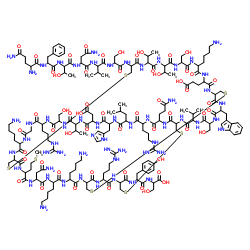Charybdotoxin

Charybdotoxin structure
|
Common Name | Charybdotoxin | ||
|---|---|---|---|---|
| CAS Number | 95751-30-7 | Molecular Weight | 4295.89 | |
| Density | N/A | Boiling Point | N/A | |
| Molecular Formula | C176H277N57O55S7 | Melting Point | N/A | |
| MSDS | USA | Flash Point | N/A | |
|
Triclosan, an environmental pollutant from health care products, evokes charybdotoxin-sensitive hyperpolarization in rat thymocytes.
Environ. Toxicol. Pharmacol. 32(3) , 417-22, (2011) The effects of triclosan, an environmental pollutant from household items and health care products, on membrane potential and intracellular Ca(2+) concentrations of rat thymocytes were examined by a flow cytometry with fluorescent probes, di-BA-C(4) and fluo-... |
|
|
Angiotensin II Type 1 receptor blockade protects endothelium-derived hyperpolarising factor-mediated relaxation in a rat model of monoarthritis.
Life Sci. 92(23) , 1131-7, (2013) Rheumatoid arthritis (RA) is associated with high cardiovascular mortality. Impaired endothelial cell (EC) function and elevated angiotensin II levels may be central to the link between vascular dysfunction and RA. Here we investigated the action of angiotens... |
|
|
The bitter taste receptor (TAS2R) agonists denatonium and chloroquine display distinct patterns of relaxation of the guinea pig trachea.
Am. J. Physiol. Lung Cell. Mol. Physiol. 303(11) , L956-66, (2012) Activation of taste receptors (TAS2Rs) by bitter taste agonists has been reported to cause bronchodilation. The aim of this study was to extend the information on the effects of bitter taste agonists on responses induced by different contractile mediators in ... |
|
|
Involvement of presynaptic voltage-dependent Kv3 channel in endothelin-1-induced inhibition of noradrenaline release from rat gastric sympathetic nerves.
Eur. J. Pharmacol. 694(1-3) , 98-103, (2012) We previously reported that two types of K(+) channels, the BK type Ca(2+)-activated K(+) channel coupled with phospholipase C (PLC) and the voltage-dependent K(+) channel (Kv channel), are, respectively, involved in the prostanoid TP receptor- and muscarinic... |
|
|
Endothelium-dependent mechanisms of the vasodilatory effect of the endocannabinoid, anandamide, in the rat pulmonary artery.
Pharmacol. Res. 66(3) , 251-9, (2012) Endocannabinoids exhibit vasodilatory properties and reduce blood pressure in vivo. However, the influence and mechanism of action of the prominent endocannabinoid, anandamide (AEA), in pulmonary arteries are not known. The present study determined the vascul... |
|
|
Involvement of different types of potassium channels in the antidepressant-like effect of ascorbic acid in the mouse tail suspension test.
Eur. J. Pharmacol. 687(1-3) , 21-7, (2012) Considering that the administration of ascorbic acid elicits an antidepressant-effect in mice by a mechanism which involves an interaction with N-methyl-D-aspartate receptors and the l-arginine-nitric oxide-cGMP pathway and taking into account that the stimul... |
|
|
Fusion expression and purification of four disulfide-rich peptides reveals enterokinase secondary cleavage sites in animal toxins.
Peptides 39 , 145-51, (2013) Animal toxins are powerful tools for testing the pharmacological, physiological, and structural characteristics of ion channels, proteases, and other receptors. However, most animal toxins are disulfide-rich peptides that are difficult to produce functionally... |
|
|
Voltage dependence of the Ca(2+)-activated K(+) channel K(Ca)3.1 in human erythroleukemia cells.
Am. J. Physiol. Cell Physiol. 304(9) , C858-72, (2013) We have isolated a K(+)-selective, Ca(2+)-dependent whole cell current and single-channel correlate in the human erythroleukemia (HEL) cell line. The whole cell current was inhibited by the intermediate-conductance KCa3.1 inhibitors clotrimazole, TRAM-34, and... |
|
|
Scorpion toxins specific for potassium (K+) channels: a historical overview of peptide bioengineering.
Toxins (Basel.) 4(11) , 1082-119, (2012) Scorpion toxins have been central to the investigation and understanding of the physiological role of potassium (K⁺) channels and their expansive function in membrane biophysics. As highly specific probes, toxins have revealed a great deal about channel struc... |
|
|
Relaxant effect of a water soluble carbon monoxide-releasing molecule (CORM-3) on spontaneously hypertensive rat aortas.
Cardiovasc. Drugs Ther. 26(4) , 285-92, (2012) Both carbon monoxide (CO) and nitric oxide (NO) are two gaseous molecules performing relevant functions in mammals. In order to better understand their actions in the cardiovascular system, we have investigated the effects of CORM-3, (tricarbonylchloro(glycin... |